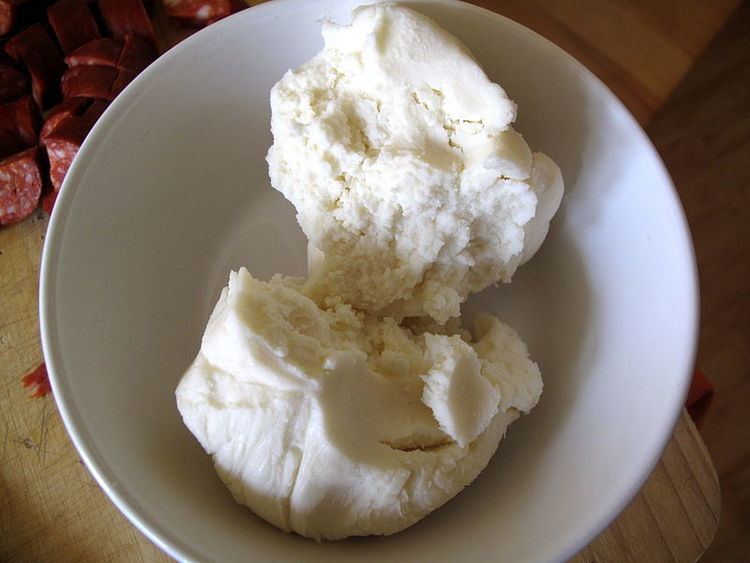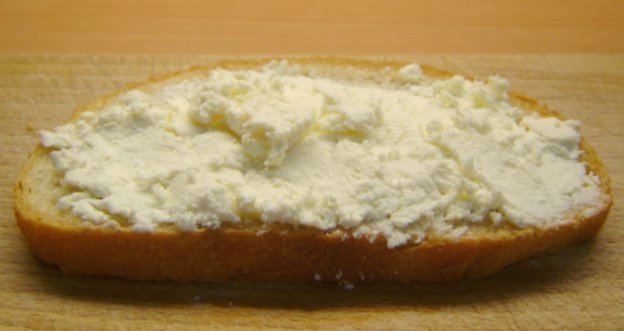Source of milk Sheep Texture Depends on variety Region Eastern Europe | Pasteurized No Fat content Depends on variety | |
 | ||
Certification Bryndza Podhalańska: PDOSlovenská bryndza: PGI Similar Sulguni, Halušky, Bryndzové halušky, Quark, Circassian cheese | ||
Strapachka small potato dumplings with bryndza cheese sztrapacska
Bryndza (from Romanian brânză) is product of a sheep milk cheese made mainly in Slovakia, Romania and Moldova, but also in Poland, Ukraine, Hungary and part of Moravia (Moravian Wallachia) in Czech Republic. Bryndza cheese is creamy white in appearance, known for its characteristic strong smell and taste. The cheese is white, tangy, crumbly and slightly moist. It has characteristic odor and flavor with a notable taste of butyric acid. The overall flavor sensation begins slightly mild, then goes strong and finally fades to a salty finish. Recipes differ slightly across countries.
Contents
- Strapachka small potato dumplings with bryndza cheese sztrapacska
- Halusky traditional slovak gnocchi with bryndza sheep s milk cheese and bacon
- Etymology
- History
- Geographical indications
- Comparable cheeses
- References

Halusky traditional slovak gnocchi with bryndza sheep s milk cheese and bacon
Etymology

Known as juhtúró in Hungarian, брынза in Russian, brenca in Serbian, Brimsen in German, and ברינזע in Yiddish, bryndza, a word borrowed from Romanian brânză ("cheese"), is used in various countries throughout Ukraine and the EU, due to its introduction by migrating Vlachs. Though the word brânză (Romanian pronunciation: [ˈbrɨnzə]) is simply the generic word for "cheese" in Romanian, there is no special type of cheese associated with it. It is a word presumably inherited by the Romanian language from Dacian, the language of the pre-Roman population in modern-day Romania. Outside Slovakia and the flanking regions of Southern Poland, it is still popular nowadays in the Czech Republic under the Czech spelling "brynza".
History
The word was first recorded as brençe, described as "Vlach cheese", in the Croatian port of Dubrovnik in 1370. Bryndza was first recorded in Kingdom of Hungary, in 1470 and in the adjacent Polish Podhale in 1527. In Slovakia, bryndza serves as the main ingredient to bryndzové halušky, which is regarded the national speciality (halušky - small gnocchi - are mixed with bryndza and topped with fried chops of fatty bacon). Bryndza is therefore regarded as typically Slovak product. The modern version of the soft spreadable bryndza is believed to have been developed by entrepreneurs from Stará Turá (Western Slovakia) toward the end of the 18th century who founded bryndza manufactures in mountainous regions of Central and Northern Slovakia where sheep cheese production had deep roots in the local cheese manufacturing tradition, and traded with it, popularizing bryndza all around the Austrian Habsburg Monarchy. In Austria, it was called Liptauer, after the northern Slovak Liptov region. The Viennese speciality Liptauer, a savoury cheese-based spread, has replaced bryndza with common cows' milk cottage cheese because the original Slovak bryndza disappeared from Austrian market after the disintegration of Austro-Hungarian monarchy.
Geographical indications

Comparable cheeses

While most of the world's commercially available cheese is made from cow's milk, many parts of the world also produce cheese made from sheep's milk well-known examples being Roquefort, produced in France, Serra da Estrela cheese from Portugal, Ricotta and Pecorino Romano, produced in Italy from ewe's milk. Sometimes cheeses marketed under the same name are made from milk of different animals - Feta style cheeses, for example, made of sheep’s milk only in Greece and from cow's milk elsewhere.
